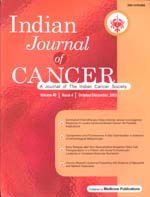
|
Indian Journal of Cancer
Medknow Publications on behalf of Indian Cancer Society
ISSN: 0019-509X
EISSN: 0019-509X
Vol. 43, No. 4, 2006, pp. 156-162
|
 Bioline Code: cn06025
Bioline Code: cn06025
Full paper language: English
Document type: Research Article
Document available free of charge
|
|
|
Indian Journal of Cancer, Vol. 43, No. 4, 2006, pp. 156-162
| en |
High-risk human papillomavirus, tumor suppressor protein p53 and mitomycin-C in invasive squamous cell carcinoma cervix
Rajaram S, Gupta G, Agarwal S, Goel N, Singh KC
Abstract
Background: Clinical data relating to human papillomavirus (HPV) infection and p53 status in cervical cancer has been sparse and confusing.
Aim: To evaluate high-risk HPV and expression of tumor suppressor protein p53 in squamous cell carcinoma of cervix and to assess response to mitomycin-C in neo-adjuvant chemotherapy.
Setting and Design : Teaching College Hospital; Gynecologic Oncology Unit and Department of Pathology. Prospective, randomized.
Materials and Methods: Expression of p53 protein was assessed, using immunohistochemistry with mouse monoclonal antibody in 30 consecutive patients undergoing radical hysterectomy or admitted for neo-adjuvant chemotherapy. Human papillomavirus DNA (HPV DNA) was assessed using hybrid capture II technology. Patients eligible for chemotherapy were randomized into vincristine, bleomycin and cisplatin (VBP) group and VBP with mitomycin C group.
Statistical Analysis : Chi-square test, one-way ANOVA, Pearson's correlation; Mann-Whitney, McNemar and Fischer's exact tests were used for statistical analysis.
Result : All patients with cancer cervix were positive for high-risk HPV DNA having relative light units/cut off values ranging from 3.4-2389.21 ( P value = 0.006). High viral load of high risk HPV DNA was seen in advanced stages ( P = 0.05) and an association of viral load with tumor volume was also seen (r=0.361, P =0.05). Analysis of p53 protein in cervical carcinoma patient showed expression in 50% of cancer specimens ( P value < 0.001). McNemar's and Fischer's exact test showed no change in p53 status post-chemotherapy; however 66% of stage II B patients in VBP-M group became operable.
Conclusion : High-risk HPV was universally present in all cases of cancer cervix and viral load was associated with stage and tumor volume while p53 protein was expressed in 50% of cases suggesting deregulation. More studies using mitomycin-C in cervical cancer treatment protocols are needed.
Keywords
p53 protein, human papillomavirus, squamous cell carcinoma cervix, mitomycin-C
|
| |
© Copyright 2006 Indian Journal of Cancer.
Alternative site location: http://www.indianjcancer.com/
|
|
